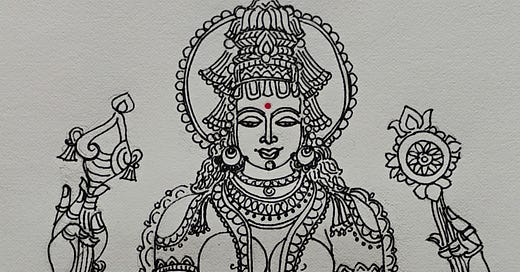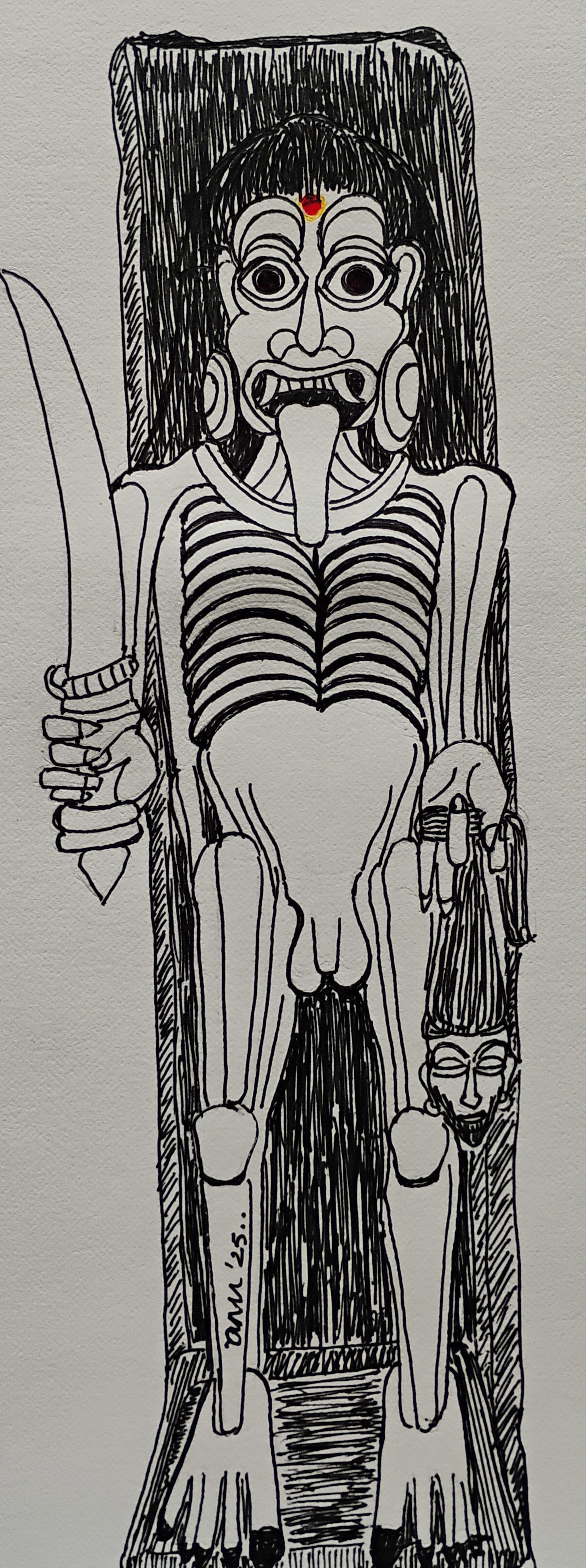The trail of temples once you enter the Hassan district in the southwest part of Karnataka, will lead you many beautiful but lesser-known edifices in this region. You are sure to feel the urge to enquire with locals, search the internet or find other ways to somehow cover all the temples in and around the area. These historic marvels leave you wondering about how it was possible for the people of that period to construct such amazing structures with the minimum available resources. One such place is the DODDAGADDAVALLI LAKSHMI TEMPLE. This temple is a representation of Shaiva and Vaishnava harmony with four deities – Mahalakshmi, Shiva, Mahakali and Vishnu all in one place. Locals call it the Brother-Sister temple. You feel lucky to have come to such less popular temples when compared to temples like the world famous Belur Chennakeshava Temple and the immediate thought is the enthusiasm of a kid, to share it with all so that they can also visit this place. So next time you happen to travel to this part of Karnataka, do not miss this temple which has a history older than Belur and Halebidu.
DODDAGADDAVALLI LAKSHMI DEVI
LOCATION
Doddagaddavalli Lakshmi Temple, as it is popularly known, is located in a small village called Doddagaddavalli in Belur Taluk, Hassan District, Karnataka, India. It is about 20 km northwest from Hassan, 16 km south of Halebidu, a beautiful Historical town (which we will be covering in future blogs) and about 25 kms southeast from Belur .
DEITIES IN THE TEMPLE
Although this temple is recognized as Goddess Lakshmi temple, this comes under the ‘CHATHUSHKOOTA’ concept of the Hoysala architecture wherein there are FOUR MAIN DEITIES in a single temple. Hence, we can see the main temple has FOUR GARBHAGRIHAS that share a common mantapa, each sanctum being a square and aligned to a cardinal direction. The eastern shrine has MAHALAKSHMI, northern shrine MAHAKALI, the western shrine LORD SHIVA and the southern shrine LORD VISHNU, which is now empty.
MAHALAKSHMI
The beautiful 3 ft tall Moorthi of Mahalakshmi is seen in a Samabhang (standing straight without any bend) posture, with four arms. The intricately carved Kirita (crown) and jewellery is a fine example of delicate Hoysala style art. She is seen holding a Shanka (conch) in her upper right hand, a Chakra (disc) in her upper left hand, a Japamala in her lower right and a Gadha (mace) in her lower left hand. We were told by the local guide that she is holding a seethaphala in her lower left hand. It is a rare sculpture of goddess Lakshmi in standing posture, since she is mostly depicted in a sitting posture. The sculpture resembles the famous Kolhapur Lakshmi Devi. We can also see two attendants on either side of the sculpture.
MAHAKALI
One can definitely feel the magnetism as you stand before the very attractive Moorthi of Mahakali who is sculpted as a Shantha swaroopi in a sitting posture. She is seen in a peaceful and serene composure after killing the asuras, Shumbha and Nishumbha. The most beautiful and attractive Devi is seated on a dead body of a rakshasa as an aasana, flanked by Shakini and Dakini. The Goddess has eight arms, spread in circular form holding various weapons. On her right, she holds the khadga, trishula, gada and arrow, while on the left, a bhiksha patra, damaru, bow and paasha are depicted. The intricate and detailed carving done on the Devi’s sculpture and the ayudhas she holds is mind-blowing.
Mahakali is worshipped as the village deity here. One unique thing you cannot miss in this temple is the entrance to the garbhagriha, which is guarded by two Betalas (Bhuta ganas who accompany the Goddess in her expeditions against evil). The nude, bigger than life size Betalas have a frightening appearance, tongues hanging out, protruding large ribs, holding a severed human head and a sword in either hand. The presence of these sculptures indicates the influence of tantric cult in the construction of the temple. Also, the doorway and its lalata pattika (upper jamb) have bhuta mukhas on either side of the doors.
You cannot but wish to keep standing forever in front of this particular Garbhagriha and feel like simply feasting your eyes and soul upon the Goddess Mahakali. There is some strong unexplained attraction to this place in the temple.
Betala guarding the gabhagriha of MahaKali
VISHNU
According to some Hindu scriptures, especially in the Vamana Purana, Durga Devi, particularly in her aspect as Parvati, is considered the sister of Lord Vishnu. This relationship is sometimes expressed with the term "Govinda-Bhagini" (sister of Govinda/Vishnu). Also, Yogamaya, who is considered a benevolent aspect of Durga and personifies Vishnu's powers of illusion, is also referred to as Narayani, the sister of Narayana (Vishnu).
Here in this temple, as if to establish the above fact, Lord Vishnu has a Garbhagriha opposite to Mahakali’s. Unfortunately, the main Moorthi is missing in the temple. When we spoke to the temple Archakar, who shared lots of information about the temple, he said that the sad part is, vandalism in this area is attributed to the present times more than during the past.
SHIVA
The Garbhagriha of Lord Shiva is placed opposite of Goddess Mahalakshmi. Here, the Lord is worshipped in the name of Bhoothanatha Linga. He is flanked by his sons Karthikeya and Ganesha.
Interestingly, the doorway of the Garbhagriha has a beautiful Gajalakshmi sculpted on the top. Also, since the Mahalakshmi here bears a resemblance to the Kolhapur temple and this is said to have been built by a merchant couple from Maharashtra, there is a possibility that people considered Lord Shiva and Devi Lakshmi as brother and sister. It mirrors the belief just like in Kolhapur that Lord Shiva in the form of Jyothiba who is said to have helped the Goddess to defeat Ratnasura. Jyothiba is also considered the brother of Goddess Mahalaxmi of Kolhapur, and is deeply revered in the region.
OTHER DEITIES IN THE TEMPLE
Inside the historic praakara are four small shrines at each corner, a design called parivaralayas in Sanskrit texts. These are now empty with the moorthis missing in the Garbhagrihas.
In addition, to the northeast of the main temple, there is a fifth independent shrine dedicated to Bhairava. The doorframe of the shrine has sculptures of Bhuta ganas tearing open their intestines while the other figure is cutting his own head. This shows the support of the tantric affiliation of MahaKali.
HISTORY AND ARCHITECTURE
The history and origin of this temple dates back to 1113 CE during the reign of King Vishnuvardhana. This is said to be the oldest surviving Hoysala temple, even older than the very famous Belur and Halebidu temples.
This temple is said to been built by the Hoysala architects Malloja and Maniyoja commissioned by a wealthy local merchant Kullahana Rahuta and his wife Sahaja Devi as mentioned in the temple inscriptions. This wealthy trader and devout bhaktha was inspired by the MahaLakshmi temple in Maharashtra’s Kolhapur and built a similar one in Doddagaddavalli. The village, historically referred to as Doddagaddumballe in inscriptions, was even renamed as Abhinava Kolhapura.
The temple is built using soapstone, which is a very soft material that hardens when exposed to air. The main temple in the centre of the 7 ft compound has four garbagrihas—making it a chatushkoota temple. The uniqueness in Hoysala temples can be identified with different numbers of garbagrihas -one (ekakoota, eg. Belur), two (dvikoota, eg. Halebidu), three (trikuta, eg. Somanathapura) and even four and five (panchakoota, eg. Govindanahalli). This is the only chatushkoota temple in Hoysala history. The four garbagrihas share a common hall and main entrance.
The lathe-turned pillars are magnificent to see. Also, one of the interesting things in this temple is the Shikaras (towers of the garbhagrihas). In Hindu temple architecture, the shikhara varies depending on the architectural style. The three main styles are Nagara, Dravida, and Vesara. Nagara temples, prevalent in northern India, feature a curved, pyramidal shikhara, while Dravidian temples, common in southern India, have a stepped pyramid-like structure called a vimana. Vesara style, a combination of both, also has distinct shikhara characteristics. In this temple, we can see the Kadamba-Nagara style shikhara (rear, left and right) for Mahakali, Shiva and Vishnu shrines whereas the Mahalakshmi shrine has a Dravida shikhara. Maybe it is Mahalakshmi shrine’s unique shikara that has resulted in the temple being named after the deity- Doddagadavalli Lakshmi Devi temple.
It is good to see that the temple has suffered considerably less damage from Islamic invasions when compared to the other temples in this region. The Kalasha, Sukanasi and the Hoysala emblem (warrior fighting a lion) are all intact. But the saddest part is that on 20 November 2020, some miscreants broke into the temple and destroyed the beautiful, and only murti of Kali from the Hoysala era.
One more beautiful aspect not to be missed here are the exquisitely carved roof panels. It always makes me wonder how can such intricacy and craftsmanship be done on the roof !! Would they sculpt the panels first and then take them to be placed above or Would they directly sculpt the ceiling?
The panel outside Mahakali’s shrine has many figures- the Rudra Tandava by Shiva playing the Rudra veena, Kubera and Rambha on a horse in the north direction, Agni riding on a one-horned ram and holding his weapon, Shakti in the south-east direction, Yama riding his buffalo and holding his danda in the South, Goddess Niruti in her human form in the south-west, and Varuna riding a crocodile in the West. In the centre of the hall is Indra with his consort Indrani riding the Airavata. Other important sculptures are those of Gajalakshmi, Tandaveshwara and Yoganarasimha found on the doorway of the temple.
May Goddess MahaLakshmi bestow her blessings on all…
namastē'stu mahāmāyē śrīpīṭhē surapūjitē ।
śaṅkhachakra gadāhastē mahālakṣmi namō'stu tē ॥
ADDRESS
DODDAGADDAVALLI LAKSHMI TEMPLE,
HAGARE, HASSAN DISTRICT,
KARNATAKA – 573216.



